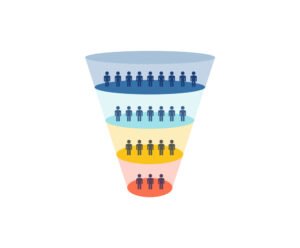In business, mastering the art of sales funnel management is paramount to achieving sustainable growth and profitability. A meticulously crafted and optimized sales funnel is the backbone of your sales strategy, guiding potential customers through a carefully curated journey that transforms them from curious onlookers into loyal patrons. In this definitive guide, we will embark on a comprehensive exploration of sales funnel management, dissecting its core principles, strategies, and best practices that will empower your business to thrive in the digital age.
What is a Sales Funnel? A Deeper Dive
A sales funnel, at its essence, is a visual metaphor that illustrates the various stages a potential customer traverses before making a purchase. It is a structured framework that highlights the gradual narrowing of the customer pool as individuals progress through the buying process, with some dropping off at different junctures due to waning interest, mismatch of needs, or alternative options.
The sales funnel is not merely a static representation; it is a dynamic ecosystem that requires continuous monitoring, analysis, and refinement. The overarching objective of sales funnel management is to optimize conversions at each stage, ensuring a smooth, engaging, and ultimately rewarding experience for potential customers.
Why is Sales Funnel Management Critical in Business?
Effective sales funnel management is the linchpin of a successful sales strategy, bestowing businesses with many benefits that reverberate throughout their operations. Let’s delve into why it’s an indispensable tool for driving growth and achieving long-term success:
- Unveiling the Customer Psyche: By meticulously analyzing the customer journey at each stage of the funnel, businesses can unlock a treasure trove of insights into customer behavior, preferences, motivations, and pain points. This invaluable information empowers businesses to craft marketing and sales messages that resonate deeply with their target audience, fostering stronger connections and driving higher engagement.
- Elevating Conversion Rates to New Heights: Identifying and rectifying bottlenecks and areas of friction within the sales funnel is a pivotal aspect of optimizing conversion rates. By understanding the specific obstacles that impede prospects from advancing to the next stage, businesses can implement targeted interventions that streamline the customer journey, resulting in a greater number of qualified leads and a substantial boost in sales figures.
- Crafting an Unforgettable Customer Experience: A well-orchestrated sales funnel places a premium on delivering a seamless, personalized, and delightful experience to potential customers. When prospects feel valued, understood, and supported throughout their journey, they are more likely to not only convert into paying customers but also become enthusiastic brand advocates who champion your products or services to others.
- Predicting the Future with Precision: The ability to accurately forecast sales is a cornerstone of effective business planning and resource allocation. By diligently tracking key metrics and analyzing data throughout the sales funnel, businesses can gain a comprehensive understanding of their sales pipeline, enabling them to anticipate future revenue streams, optimize inventory levels, and make informed decisions that drive sustainable growth.
- Unleashing the Power of Revenue and Profitability: The ultimate raison d’être of sales funnel management is to fuel revenue generation and bolster profitability. By meticulously optimizing each stage of the funnel, businesses can attract a larger influx of qualified leads, successfully convert a higher percentage of those leads into paying customers, and ultimately maximize their return on investment (ROI).
The Stages of a Sales Funnel: A Detailed Exploration

Understanding the intricate dance of the sales funnel necessitates thoroughly examining its constituent stages. Each stage represents a distinct phase in the customer journey, requiring tailored strategies and tactics to guide prospects toward the ultimate goal of conversion.
1. Awareness: Igniting the Spark of Interest
The awareness stage marks the inception of the customer journey, where potential customers first encounter your brand, product, or service. This initial touchpoint can occur through a myriad of channels, including online advertising, social media campaigns, content marketing endeavors, search engine optimization (SEO), public relations initiatives, or even word-of-mouth referrals.
At this stage, the primary objective is to capture the attention of your target audience and pique their curiosity. This can be achieved by crafting compelling content that addresses their pain points, showcases the unique value proposition of your offering, and leaves them yearning for more information.
2. Interest: Nurturing the Flame of Curiosity
As prospects progress to the interest stage, they have transitioned from passive observers to active information seekers. They are now actively researching your brand, exploring your website, perusing your blog posts, or downloading your whitepapers.
The goal at this stage is to nurture their burgeoning interest by providing them with relevant, informative, and engaging content that further educates them about your product or service. This is the time to showcase customer testimonials, case studies, and product demos that highlight the tangible benefits and transformative potential of your offering.
3. Consideration: Weighing the Options
The consideration stage is a critical juncture in the customer journey, where prospects are meticulously evaluating your product or service against competing alternatives. They are delving deeper into the features, functionalities, pricing, and overall value proposition to determine if your offering aligns with their specific needs and preferences.
At this stage, it’s imperative to provide prospects with comprehensive information that enables them to make an informed decision. This can be achieved through detailed product comparisons, competitive analysis, expert reviews, and personalized consultations that address their specific queries and concerns.
4. Intent: Signaling a Strong Propensity to Buy
Prospects who have reached the intent stage have exhibited a clear intention to purchase your product or service. This can manifest in various ways, such as adding items to their shopping cart, requesting a quote, signing up for a free trial, or initiating contact with your sales team.
The focus at this stage shifts to nurturing the prospect’s intent and guiding them toward a seamless conversion. This can involve offering limited-time discounts, exclusive bonuses, or personalized recommendations that create a sense of urgency and incentivize them to take the final step.
5. Evaluation: The Final Hurdle Before Conversion
As prospects enter the evaluation stage, they are on the cusp of making a purchase decision. They may be engaged in final negotiations, seeking approvals from stakeholders, or conducting a final assessment of the terms and conditions.
The objective at this stage is to assuage any lingering doubts or concerns the prospect may have. This can be accomplished by providing exceptional customer service, addressing any last-minute questions, and offering flexible payment options that cater to their individual needs.
6. Purchase: Sealing the Deal
The purchase stage marks the culmination of the customer journey, where the prospect transforms into a paying customer. This is the moment of truth where all your efforts to attract, nurture, and convert the prospect finally bear fruit.
While the purchase itself is a momentous occasion, it’s important to remember that it’s not the end of the customer journey. It’s merely the beginning of a new chapter – the loyalty stage.
7. Loyalty: Cultivating Lifelong Advocates
The loyalty stage is where businesses have the opportunity to foster lasting relationships with their customers. By providing exceptional customer service, delivering on their promises, and exceeding expectations, businesses can cultivate a loyal customer base that not only generates repeat business but also becomes a powerful source of word-of-mouth marketing.
Nurturing customer loyalty involves a multifaceted approach that includes personalized communication, exclusive offers, loyalty programs, and proactive engagement. By consistently delivering value and exceeding expectations, businesses can transform one-time buyers into lifelong advocates who champion their brand and contribute to their long-term success.
How to Build a Sales Funnel: A Step-by-Step Blueprint
Building a high-performing sales funnel is not a haphazard endeavor; it requires a meticulous and strategic approach that encompasses various facets of your marketing and sales efforts. Let’s break down the key steps involved in crafting a sales funnel that propels your business to new heights:
- Define Your Target Audience with Laser Precision: The cornerstone of any successful sales funnel is a deep understanding of your target audience. Delve into their demographics, psychographics, interests, pain points, and buying behaviors. Create detailed buyer personas that encapsulate the characteristics, motivations, and challenges of your ideal customers.
- Craft Compelling Content That Resonates: Content is the lifeblood of your sales funnel. Develop a content strategy that aligns with the interests and needs of your target audience at each stage of the funnel. This can include blog posts that educate and inform, videos that entertain and engage, infographics that simplify complex concepts, ebooks that offer in-depth insights, webinars that foster interaction, and social media posts that spark conversations.
- Optimize Your Website for Conversions: Your website is often the first point of contact for potential customers. Ensure that it’s not only visually appealing and user-friendly but also optimized for conversions. Create clear and compelling calls to action (CTAs) that guide visitors through the funnel and encourage them to take the next step. Implement lead capture forms, live chat functionality, and personalized recommendations to enhance the user experience and capture valuable lead information.
- Nurture Leads with Automated Campaigns: Lead nurturing is the process of cultivating relationships with potential customers by providing them with relevant content and offers over time. Implement automated email campaigns that deliver targeted messages based on the prospect’s interests, engagement level, and position in the sales funnel. This helps to build trust, establish credibility, and move prospects closer to a purchase decision.
- Track, Analyze, and Optimize Relentlessly: Data is the bedrock of informed decision-making. Regularly track and analyze key metrics, such as website traffic, lead generation, conversion rates, customer acquisition cost (CAC), customer lifetime value (CLTV), sales cycle length, and average deal size. This data-driven approach allows you to pinpoint areas for improvement and make strategic adjustments that yield optimal results.
Navigating the Challenges of Sales Funnel Management: A Strategic Approach

While the concept of a sales funnel may seem straightforward, its effective management is fraught with challenges that can derail even the most well-intentioned efforts. Let’s delve into some of the most common obstacles that businesses encounter and explore strategies for overcoming them:
- The Quest for Quality Leads: Not all leads are created equal. Some may lack the budget, authority, need, or timeline (BANT) to become paying customers. It’s essential to implement a rigorous lead qualification process that filters out unqualified leads, ensuring that your sales team focuses their valuable time and resources on prospects with the highest potential for conversion.
- Plugging the Leaks in Your Funnel: Lead leakage, the phenomenon of prospects dropping out of the funnel at various stages, is a pervasive issue that can significantly impact your sales performance. The reasons for lead leakage are diverse, ranging from lack of engagement and compelling offers to a subpar customer experience. By identifying the root causes of lead leakage and implementing corrective measures, you can significantly reduce attrition and maximize conversions.
- Bridging the Sales and Marketing Divide: In many organizations, the sales and marketing departments operate in silos, with disparate goals and communication breakdowns. This misalignment can create friction within the sales funnel, hindering lead nurturing and impeding the smooth flow of prospects through the pipeline. Fostering a culture of collaboration and open communication between these two crucial departments is essential for ensuring a cohesive and effective sales funnel strategy.
- Ensuring Data Accuracy and Integrity: Data is the lifeblood of any sales funnel. Inaccurate, incomplete, or outdated data can lead to misguided decisions, flawed strategies, and missed opportunities. Implementing a robust data management system that captures, cleanses, and enriches lead data is paramount for ensuring the accuracy and integrity of your sales funnel insights.
Best Practices for Sales Funnel Management: A Roadmap to Success
To navigate the complexities of sales funnel management and achieve optimal results, it’s crucial to adhere to a set of proven best practices that have stood the test of time. Let’s explore some of the most effective strategies for maximizing your sales funnel performance:
- Crafting a Holistic Sales Funnel Strategy: A well-defined sales funnel strategy is the cornerstone of success. Start by articulating clear goals and objectives for each stage of the funnel. Identify the key performance indicators (KPIs) you will track to measure progress and success. Develop a comprehensive plan that outlines the specific tactics, channels, and resources you will deploy to attract, nurture, and convert leads.
- Implementing a Robust Lead Scoring System: Lead scoring is a methodology that assigns numerical values to leads based on their level of engagement, demographic attributes, and fit with your ideal customer profile. By implementing a lead scoring system, you can prioritize leads based on their potential value, allowing your sales team to focus their efforts on the most promising prospects.
- Personalizing Your Communication at Scale: In today’s hyper-personalized world, generic, one-size-fits-all communication simply won’t cut it. Tailor your messages to the specific needs, interests, and pain points of each prospect. Leverage their name, reference their previous interactions, and provide them with content and offers that are relevant to their unique situation.
- Harnessing the Power of Automation: Automation is a game-changer in the realm of sales funnel management. By automating repetitive tasks such as lead nurturing, email marketing, and social media posting, you can free up your team’s valuable time to focus on high-impact activities such as building relationships, closing deals, and providing exceptional customer service.
- Embracing a Culture of Continuous Testing and Optimization: The sales funnel is not a static entity; it’s a dynamic system that requires continuous monitoring, analysis, and refinement. Regularly test different elements of your funnel, such as headlines, calls to action, landing pages, and email subject lines. Use A/B testing to compare different variations and identify the most effective approaches.
Sales Funnel Metrics: Quantifying Your Triumphs
The ability to measure your sales funnel performance is crucial for identifying areas of strength and weakness, making data-driven decisions, and optimizing your overall sales strategy. Let’s delve into some of the most critical metrics you should track:
- Website Traffic: This metric measures the number of visitors to your website, providing insights into the effectiveness of your marketing efforts and the overall reach of your brand.
- Lead Generation: Track the number of leads generated through various channels, such as organic search, paid advertising, social media, and referrals. This metric helps you assess the effectiveness of your lead-generation strategies and identify areas for improvement.
- Conversion Rates: This metric measures the percentage of leads that successfully progress from one stage of the funnel to the next. By analyzing conversion rates at each stage, you can pinpoint bottlenecks and implement targeted interventions to enhance the flow of prospects through the funnel.
- Customer Acquisition Cost (CAC): CAC is the average cost incurred to acquire a new customer. By tracking this metric, you can assess the efficiency of your marketing and sales efforts and identify opportunities for cost optimization.
- Customer Lifetime Value (CLTV): CLTV represents the total revenue a customer is expected to generate over their lifetime. This metric is crucial for understanding the long-term value of your customers and making informed decisions about customer acquisition and retention strategies.
- Sales Cycle Length: This metric measures the average time it takes to close a deal. By analyzing your sales cycle length, you can identify opportunities to streamline your sales process and accelerate the conversion of leads into paying customers.
- Average Deal Size: This metric measures the average value of a closed deal. By tracking your average deal size, you can assess the effectiveness of your pricing strategy and identify opportunities to increase the value of each sale.
FAQs about Sales Funnel Management
1. How long does it take to build a sales funnel?
The timeline for building a sales funnel can vary significantly depending on the complexity of your product or service, the size of your target audience, and the resources you have available. However, it’s generally advisable to start with a simple funnel and gradually iterate and refine it as you gather data and insights.
2. What are some common pitfalls businesses should avoid when managing their sales funnel?
Common mistakes include neglecting to clearly define the target audience, prioritizing quantity over quality when generating leads, failing to personalize communication, not tracking and analyzing metrics, and not continuously testing and optimizing the funnel.
3. What are some effective tools for managing a sales funnel?
A plethora of tools can streamline and enhance your sales funnel management efforts. These include Customer Relationship Management (CRM) software, email marketing platforms, marketing automation tools, lead-scoring solutions, and analytics software.
In Conclusion
Sales funnel management is not merely a tactical approach; it’s a strategic imperative that can propel your business to unprecedented levels of success. By comprehending the intricacies of the customer journey, implementing proven best practices, and leveraging data-driven insights, you can unlock the full potential of your sales funnel and achieve sustainable growth in the ever-evolving digital landscape. Remember, the sales funnel is not a static entity; it’s a dynamic ecosystem that requires constant nurturing, optimization, and adaptation to meet the ever-changing needs and expectations of your target audience. By embracing a customer-centric approach and continuously refining your sales funnel strategies, you can forge lasting relationships with your customers, drive revenue growth, and establish your brand as a leader in your industry.



